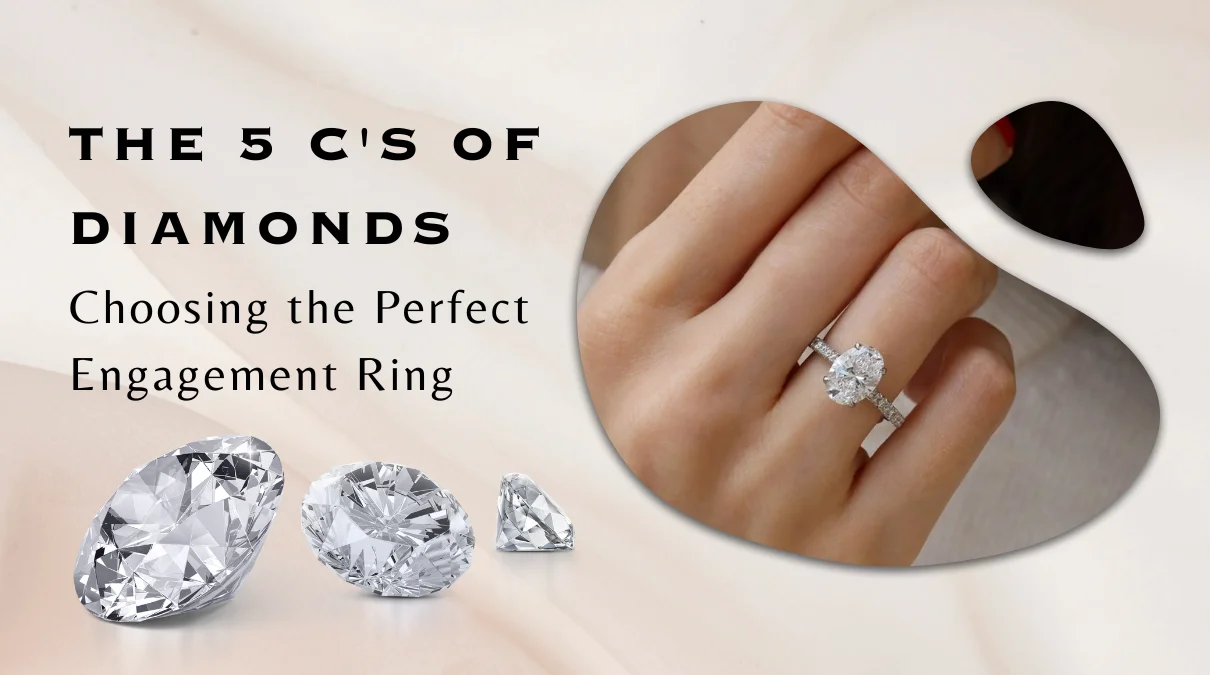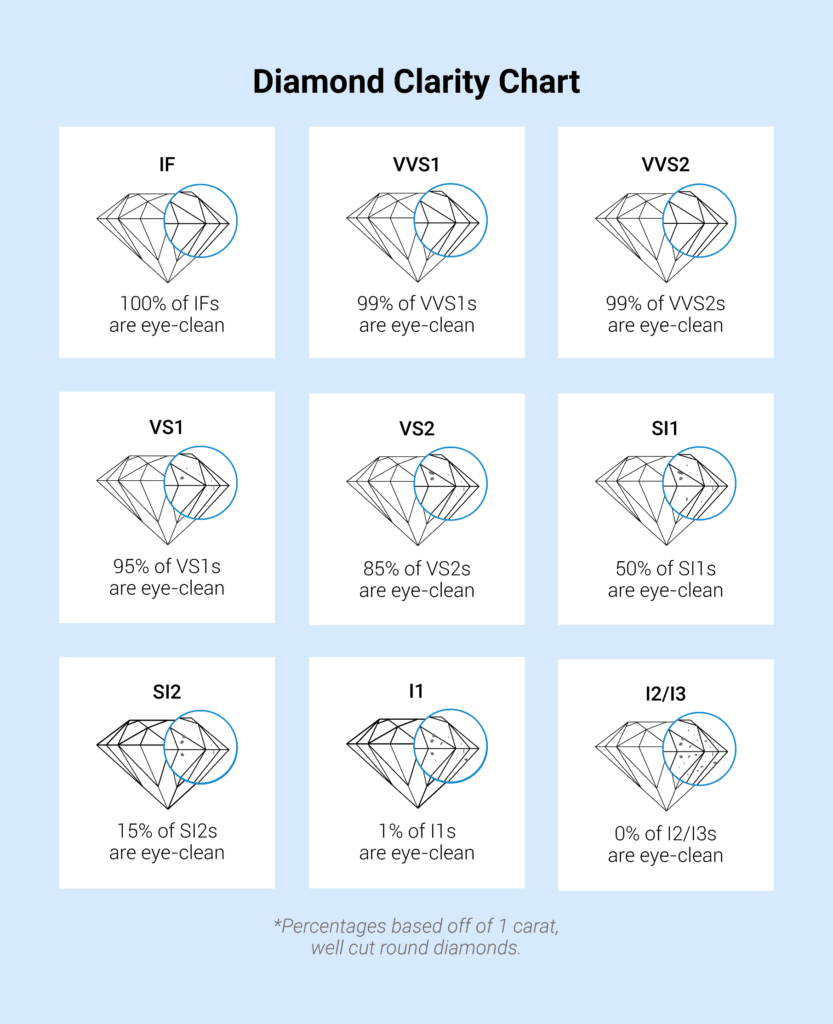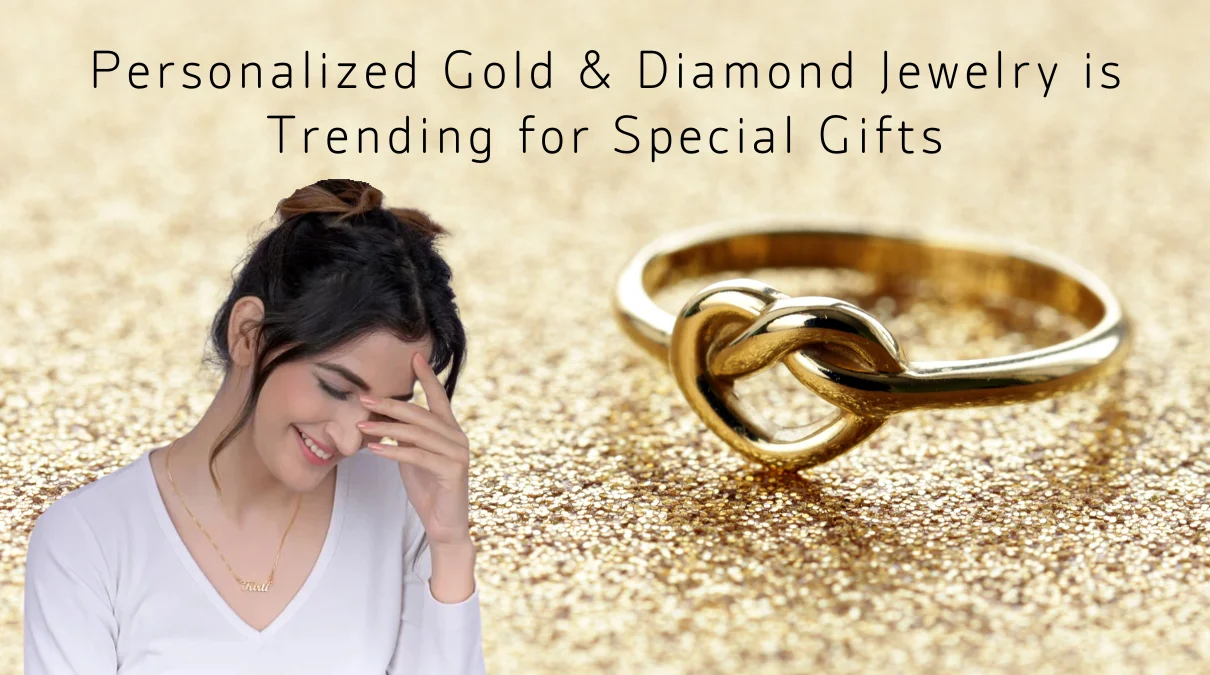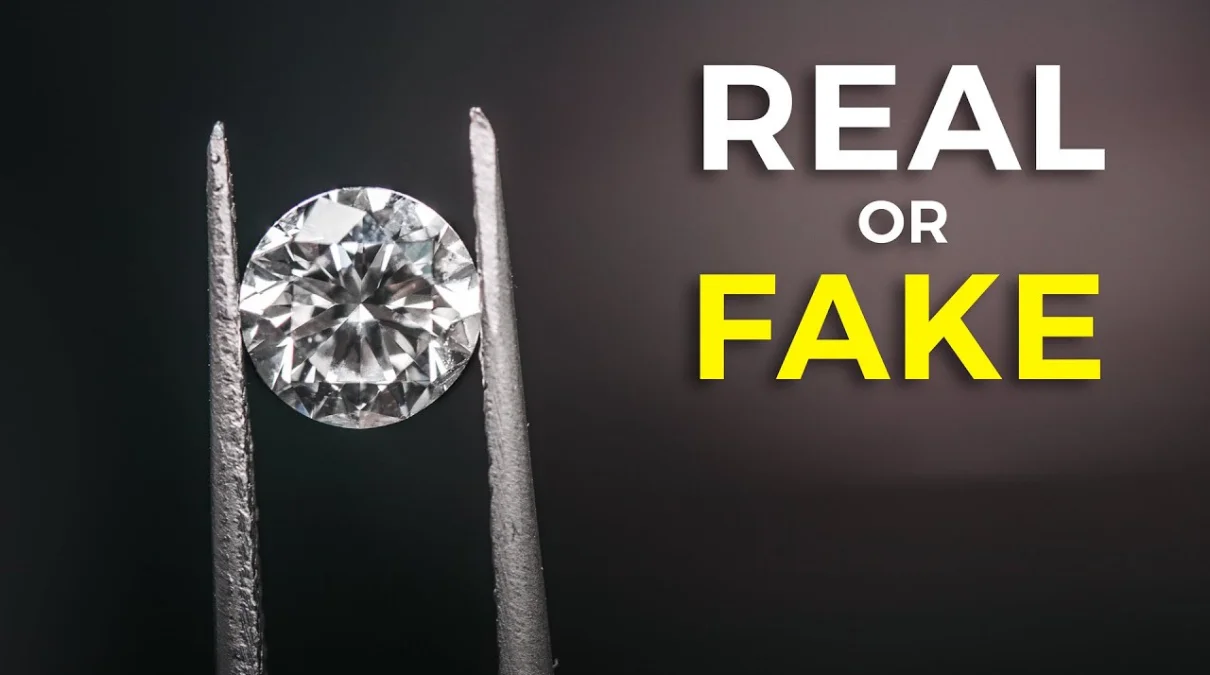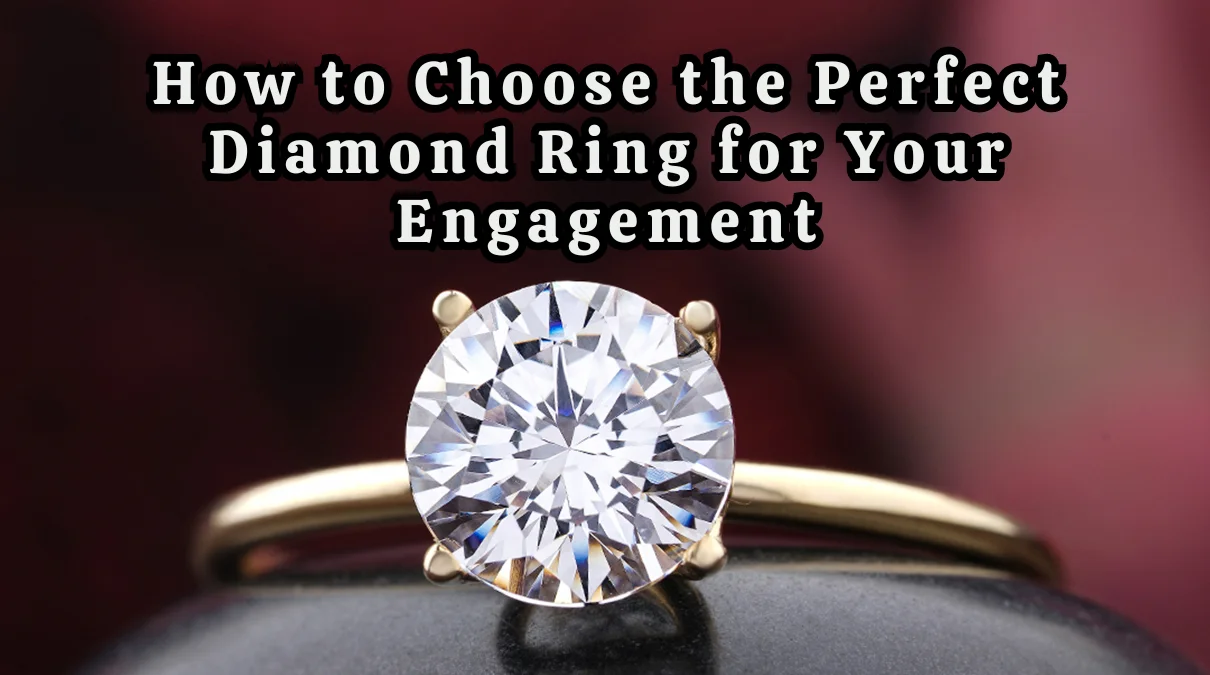The 5 C’s of Diamonds Explained: Choosing the Perfect Engagement Ring
Diamonds are often regarded as the ultimate symbol of love and commitment. When selecting an engagement ring, the diamond at its center serves as both a personal expression and a lasting treasure. The process, however, can be daunting. To ensure that you choose the perfect diamond, understanding the “5 C’s of Diamonds” is crucial. These five elements – Cut, Color, Clarity, Carat, and Certification – will help you evaluate a diamond’s quality, beauty, and value.
In this comprehensive guide, we’ll walk you through each of the 5 C’s in detail and provide tips for making an informed decision, ensuring that the diamond you select is not only breathtaking but also represents a smart investment.
-
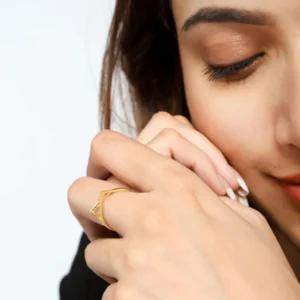
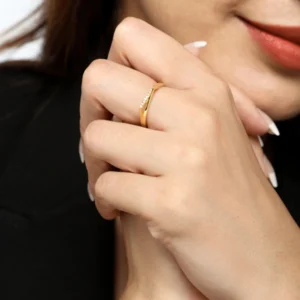 14KT Gold Diamond Barb Ring₹24,500.00
14KT Gold Diamond Barb Ring₹24,500.00 -

 Gold Natural Diamonds Hearty Band₹11,500.00
Gold Natural Diamonds Hearty Band₹11,500.00 -

 14KT Gold Diamond Studded Crown Ring₹16,000.00
14KT Gold Diamond Studded Crown Ring₹16,000.00 -

 Gold Natural Diamond Studded Heart Ring₹15,000.00
Gold Natural Diamond Studded Heart Ring₹15,000.00 -
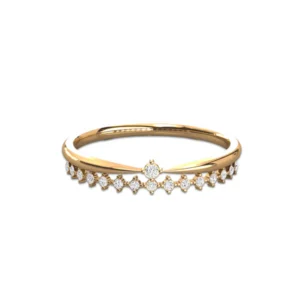
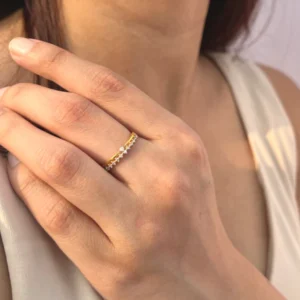 Gold Diamond Double Crown Wedding Ring₹16,000.00
Gold Diamond Double Crown Wedding Ring₹16,000.00
#1. Cut: The Key to a Diamond’s Sparkle
The cut of a diamond is often considered the most important of the 5 C’s. It determines how well the diamond reflects light, giving it that signature sparkle or brilliance. Many people confuse cut with shape (like round, oval, or pear), but the cut actually refers to how well the facets of a diamond are proportioned and polished.
Why Cut Matters
The cut is responsible for the way light travels through the diamond, creating its fire (rainbow flashes) and brilliance (white light reflection). A poor cut will make even a colorless diamond appear dull, whereas a well-cut diamond can look larger and more brilliant than it is.
Cut Grades
Diamonds are graded by their cut on a scale from Excellent to Poor:
- Excellent: Maximum brilliance and sparkle, ideal for engagement rings.
- Very Good: Excellent light performance with slight variations.
- Good: Decent brilliance but not as reflective.
- Fair & Poor: Significantly less sparkle and fire due to poor proportions.
Tips for Choosing a Cut
- Round Brilliant cuts are often the most sparkling and universally flattering.
- If sparkle is a priority, consider investing more in cut over carat weight.
- Fancy shapes (e.g., princess, cushion, or emerald) offer unique beauty and often come at a lower price per carat compared to round diamonds.
#2. Color: The Absence of Color
The color of a diamond refers to the amount of yellowish tint within the stone. The best diamonds are colorless, allowing more light to pass through and enhancing their brilliance. The color scale runs from D (completely colorless) to Z (noticeable yellow or brown tint).
Color Grading System
- D-F: Colorless – The highest grade, rare and the most expensive.
- G-J: Near colorless – Slight color but still appears colorless to the naked eye.
- K-M: Faint color – Noticeable color visible in larger diamonds or under magnification.
- N-Z: Very light to light color – Clearly visible color, often seen in lower-quality diamonds.
How to Balance Color and Budget
- Most engagement ring buyers find that diamonds in the G-H range offer the perfect balance of near-colorlessness and affordability.
- K-M diamonds can still look stunning in yellow or rose gold settings, as the metal’s warmth complements the diamond’s hue.
Tips for Color Choice
- If you are setting the diamond in white gold or platinum, aim for a color grade of D-H to avoid any noticeable yellow tint.
- Diamonds that are smaller or less exposed (like those in a halo setting) can often get away with lower color grades, making them a good budget-friendly option.
#3. Clarity: The Purity of the Diamond
Clarity measures the internal flaws (inclusions) and external blemishes of a diamond. Most inclusions are not visible to the naked eye but can impact the diamond’s overall brilliance and value.
Clarity Grading Scale
- Flawless (FL): No inclusions or blemishes visible under 10x magnification.
- Internally Flawless (IF): No inclusions, only minor blemishes visible under magnification.
- Very Slightly Included (VVS1, VVS2): Extremely difficult to see even under magnification.
- Very Slightly Included (VS1, VS2): Minor inclusions, difficult to see without magnification.
- Slightly Included (SI1, SI2): Inclusions visible under magnification, sometimes visible to the naked eye.
- Included (I1, I2, I3): Obvious inclusions that may affect brilliance and durability.
Tips for Choosing Clarity
- VS1 and VS2 diamonds offer the best balance of value and appearance, as inclusions are difficult to see with the naked eye.
- SI1 diamonds are a great option for budget-conscious buyers, as they can appear flawless to the naked eye when well-cut.
- Avoid I grade diamonds for engagement rings, as the inclusions can affect both appearance and durability.
#4. Carat: The Diamond’s Weight
Carat refers to the weight of the diamond, not its size. One carat is equivalent to 0.2 grams. Larger diamonds are rarer, making carat weight one of the biggest factors in a diamond’s price.
Understanding Carat
- 1.00 carat diamonds are highly sought after, but the average size for an engagement ring diamond is between 0.50 and 1.50 carats.
- Carat weight alone does not determine a diamond’s beauty. A smaller, well-cut diamond can appear more brilliant than a larger, poorly cut one.
Tips for Carat Selection
- Visual size matters: Diamonds with larger table surfaces (like an emerald cut) can appear larger than a round brilliant of the same weight.
- Consider the ring’s setting; a halo or other intricate design can make a smaller diamond look larger.
- If you’re on a budget, aim for a diamond that’s slightly under whole carat sizes (like 0.95 carats instead of 1.00). These diamonds often come at a significant discount without a noticeable size difference.
#5. Certification: The Diamond’s Authenticity and Quality Assurance
A diamond’s certification is the fifth and often overlooked “C.” It is an official document from a gemological lab that verifies the diamond’s quality based on the first four C’s.
Popular Certification Bodies
- GIA (Gemological Institute of America): The most trusted and respected grading authority.
- AGS (American Gem Society): Known for strict grading standards.
- IGI (International Gemological Institute): Commonly used by jewelry retailers.
- EGL (European Gemological Laboratory): Often grades diamonds slightly more leniently than GIA or AGS.
Why Certification Matters
- A diamond’s certification gives you peace of mind that you’re getting what you pay for.
- Certifications from reputable labs ensure that the diamond’s attributes are accurately represented, protecting you from overpaying.
Tips for Choosing Certified Diamonds
- Always purchase a diamond that comes with a certification from a trusted lab like GIA or AGS.
- Avoid diamonds without certification or from less-reputable labs, as these often misrepresent the stone’s quality.
-

 14KT Gold Diamond Barb Ring₹24,500.00
14KT Gold Diamond Barb Ring₹24,500.00 -

 14KT Gold Diamond Studded Crown Ring₹16,000.00
14KT Gold Diamond Studded Crown Ring₹16,000.00 -

 14KT Gold Meridian Solitaire Diamond Ring₹42,000.00
14KT Gold Meridian Solitaire Diamond Ring₹42,000.00 -

 14KT Gold Natural Diamond Spring Ring₹12,500.00
14KT Gold Natural Diamond Spring Ring₹12,500.00 -

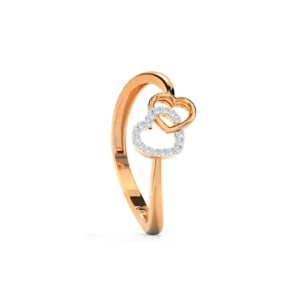
FAQs on Choosing the Perfect Engagement Ring
1. What is the most important C in the 5 C’s of diamonds?
–> The cut is often considered the most important factor, as it directly influences the diamond’s brilliance and sparkle.
2. Does a higher carat mean a better diamond?
–> Not necessarily. While carat weight impacts the diamond’s size, its cut, clarity, and color are just as important in determining overall beauty and value.
3. How can I maximize my budget when choosing a diamond?
–> To get the most value for your money, prioritize cut and choose diamonds slightly below whole carat sizes (e.g., 0.9 instead of 1.0 carats).
4. Should I buy a diamond with visible inclusions?
–> If the inclusions are not visible to the naked eye, choosing a lower clarity grade can be a great way to save money.
5. Which diamond shape gives the most sparkle?
–> The round brilliant cut is the most popular shape for maximizing sparkle due to its 58 precisely cut facets.
6. Is a GIA certification necessary?
–> A GIA certification is highly recommended as it ensures that the diamond’s quality is accurately represented.
Conclusion
Understanding the 5 C’s of diamonds – Cut, Color, Clarity, Carat, and Certification – equips you with the knowledge needed to select the perfect diamond engagement ring. By carefully evaluating these factors and balancing them with your budget, you can find a beautiful, high-quality diamond that symbolizes your commitment and love for years to come.
For those looking to make a smart investment, never underestimate the importance of certification, and always prioritize a well-cut diamond for maximum brilliance.

